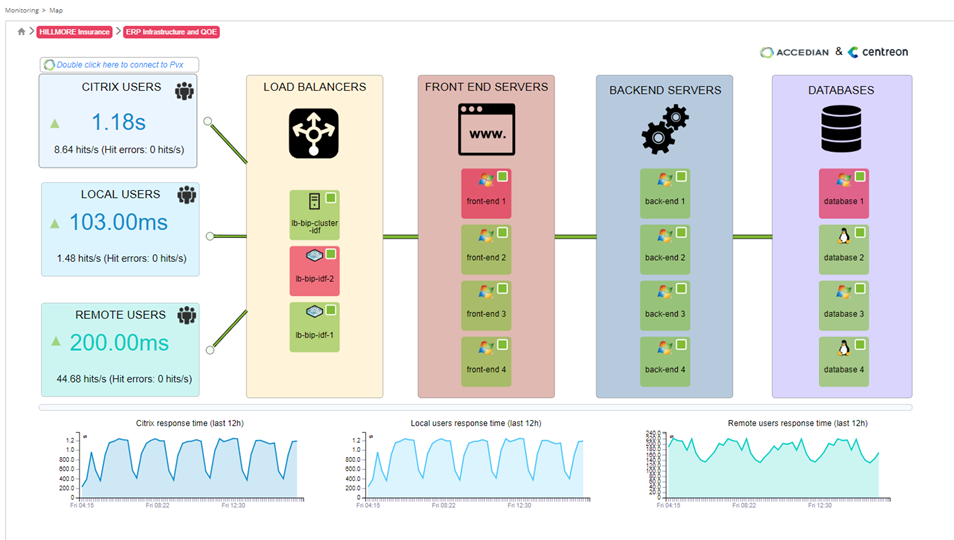Managing Multi-Cloud Environments
Anyone looking up to the sky will notice: Cloud computing is not the monolithic entity most of us would want it to be. There is more than one cloud out there and it’s increasingly the case in your own patch of sky. The untold definition of multicloud could very well be: “a complex array of vendors and their tribe of monitoring solutions”. The busier your sky, the greater the consequences for monitoring and analyzing the availability and performance of your IT infrastructure.
This post has you gazing up at the cloud landscape and then takes you back to ground level, with sound strategies that will help with monitoring multicloud environments. No seat belt required.
You’d rather get to some tutorials first? Here they are – and register to our newsletter to get more:
– How to monitor Amazon Web Services
– How to monitor Microsoft Azure
A recent IDC1 study revealed that although 42% of organizations use multicloud solutions, a majority of businesses tend to think of their cloud assets in a monolithic way—even if the word in fact refers to numerous assets deployed through various vendors. This means that most organizations basically want to manage their cloud assets as “one single portfolio”. But reality does not live up to expectations. Managing multiple vendors is exactly what it sounds like: Demanding.
See how Centreon EMS 19.04 is making multicloud monitoring easier.
There’s a good reason the transition to the cloud did not happen in a “Beam me up, Scotty” sort of way, to a single cloud provider: Most businesses have chosen a wide range of cloud services to meet a diversity of needs, opting for the best provider after a case-by-case requirements analysis. After all, the plan was to gain agility, resilience, and cut down on costs—advantages that would be hard to maintain in a single vendor scheme. There are plenty of other obvious reasons, like security as well as risks associated with vendor lock-in.
“Organizations leverage almost 5 clouds on average—yet only 31 percent of SMBs have a central cloud team.” 2
A multicloud architecture therefore is the best solution, one that is more accessible than ever to SMBs. But the change has diverse impact on the daily reality of I&O. A multicloud architecture will also require the adoption of a different approach in the organization and execution of IT operations and monitoring.
Trouble in the Back End
Accentuated reliance on a greater number of cloud options and vendors is putting extra pressure on the service management and monitoring front, including the following:
- I&O managers must determine which workload is best suited to a location—and they need to mitigate the loss of control over monitoring operations while remaining fully responsible for global service delivery.
- I&O teams are scrambling to acquire the abilities and awareness needed to master their new environment, getting acquainted with vendors and their proprietary tools, KPIs, along with a fresh crop of integration issues.
- With the multiplication of IT assets comes the multiplication of IT monitoring tools. Chances are IT monitoring teams were not a party at the initial procurement decisions, but the new IT environment is now forcing a radical change in the IT infrastructure monitoring practices.
No Rain on Your Parade
If the complexity of your multicloud architecture is getting overwhelming, with lightning and thunder about to erupt, the best line of defense will always be a good umbrella, in this case a solid, all-encompassing IT monitoring platform.
Here are a few monitoring strategies that might provide adequate protection:
- Create a single line of sight that “connects” all of your clouds, allowing you to gather and share data across cloud assets, regardless of vendors or type of technology: public, private, containers, Docker, etc.
- Organize and plan your monitoring dashboards so that you get a clear view of each business application—regardless of which cloud holds which workload.
- Create one dashboard per cloud provider, providing your teams with more control over SLAs and costs, and simplifying the learning and onboarding process with each vendor.
- Plan your monitoring perimeter and dashboards so that you have a clear view on the underlying or adjacent services that support the services located in the cloud. For example, network, legacy or connected objects, etc.
- Make sure your monitoring solution integrates availability and performance monitoring with your service request management solution.
- Find a unified way to orchestrate the alerting scheme for all your assets at once—don’t drown in competing alerts and notices while clearly establishing lines of responsibility between you and vendor teams.
What Makes a Good “Umbrella” Monitoring Solution
A good umbrella solution is a platform that will be able to collect monitoring data from all cloud and non-cloud technologies. It will lean on the provider’s monitoring tools rather than seek to replace them. Just as you’d be using only one umbrella to protect yourself from the rain. Your IT monitoring solution should be all you need to face any kind of weather.
See Through the Clouds and More with Centreon
Centreon knows the “clouds” and is able to integrate and monitor your entire ecosystem into clean and relevant dashboards that will resonate with all of your team—from first-level support to DevOps to IT service management chiefs.
If you’re dealing with multicloud architecture, ask us to help with:
- Monitoring all of your cloud and legacy assets—through our 300+ Plugin Packs
- Advising on how to combine your umbrella monitoring solution with the cloud providers’ dedicated tools.
- Monitoring end-to-end applications that cross multiple cloud and legacy technologies
- Designing your own graphical dashboards to see and share KPIs
- Completely reinventing how you manage IT service and monitor infrastructure with Centreon EMS—a platform that integrates powerful mapping and monitoring capabilities with robust analytics and reporting tools.
Let’s chat about the clouds—there’s plenty to think of.
More Reading:
- 3 Compelling Reasons to Monitor With Centreon EMS 19.04
- How to monitor Amazon Web Services
- How to monitor Microsoft Azure
- Criteria to choose the right monitoring platform
- Integrating AWS resources into a central monitoring solution
1 IDC, 2018 CLOUD COMPUTING SURVEY: “More than half (51%) of companies now think of their cloud providers as a portfolio that needs to be managed as a whole rather than as individual parts, even as they migrate more applications to more vendors in more clouds.”
2 RightScale 2018 State of the Cloud Report.









